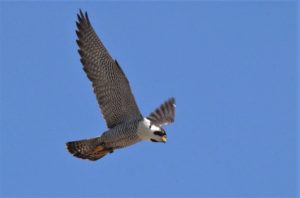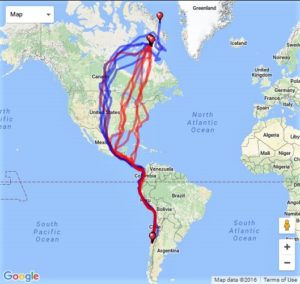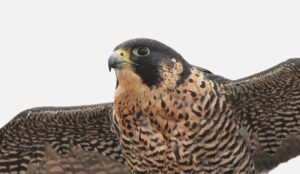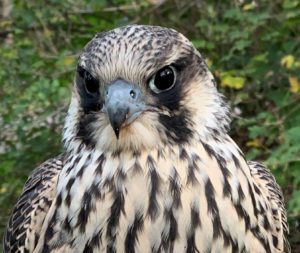Photography courtesy of Lowell Washburn, all rights reserved.
Duluth, Mn. – Situated above Lake Superior’s northern shore, the Hawk Ridge Observatory is one of America’s most popular birding hotspots. During autumn migration, the observatory may host up to 20,000 visitors who come from far and wide to witness the grand passage of nearly twenty species of southbound raptors. The winged hunters come in all shapes and sizes from the majestic golden and bald eagles, down to the diminutive blue jay-sized kestrels and sharp-shinned hawks. But although all raptors are held in awe, the species visiting ‘Hawk Heads’ most hope to see is the peregrine falcon – the legendary Duck Hawk – the ultimate Top Guns of the feathered parade.

Known to science as Falco peregrinus, the name peregrine means wandering falcon – and wander they do. Abandoning their summer nesting areas in the Canadian arctic and coastal Greenland, peregrines are currently streaming toward South American wintering grounds. One of the best places to catch a glimpse the high-speed migration is here at Lake Superior where traveling raptors – including arctic falcons – tend to stack up before staging a migratory detour along the lake’s 350-mile-long northern shoreline. But although modern-day peregrines have been completely removed from the federally endangered and threatened species lists, spotting the bird remains a comparatively rare treat. Whenever the legendary ‘duck hawk’ passes a crowd of binocular and telephoto bearing onlookers, the event never fails to incite a boisterous eruption of cheers, fist pumps, and high fives.

Life in the wild is a tough proposition. Leaving the summer nesting grounds as inexperienced hunters, all raptors — including arctic peregrines — struggle during their first migration. With peregrines, each and every meal is dependent upon the success of a death-defying high-speed chase. There is little room for error and at least 60 percent of the first-year birds will perish. The good news is that for those who successfully complete the migration, survival for subsequent years increases dramatically.
A falcon named Island Girl provides a remarkable example of long-term survivorship. Island Girl was initially captured on her Chilean wintering ground by the Washington based Southern Cross Peregrine Project on March 15, 2009. At least two years old at the time of her capture, the peregrine was fitted with a long-lived satellite transmitter that would ultimately yield some amazing data regarding the life cycle of this astonishing species.

Before her transmitter expired three years ago, Island Girl completed nine additional 18,000-mile round trip migrations leading from her arctic cliff ledge nesting site on Canada’s Baffin Island to the wintering ground in southern Chile. The combined migrations were the equivalent of seven times the circumference the earth. Amazingly consistent in her migration dates, Island Girl usually departed Baffin Island on September 20 or 21. Although fall migration routes varied, they often led from arctic Canada to the Great Lakes and then southward down the Mississippi river. On some years, the fall migration took a more easterly route, traveling over Florida and Cuba before turning southwest toward Chile. During one migration, satellite trackers found Island Girl following the shoreline of Lake Superior at midmorning. By sunset, she had traveled an additional 398 miles and ended up roosting near Davenport, Iowa. Within ten days of leaving her arctic homeland, Island Girl could often be found winging across the open expanse of the Gulf of Mexico. Upon reaching landfall, her journey would continue southward along the western coast of South America until arriving in southern Chile. With the urge to migrate suddenly quenched, Island Girl would spend the winter hunting shorebirds, gulls and other game within a relatively small area. As the season waned, the falcon would once again respond to the irresistible call of her Baffin Island cliff ledge. Bidding farewell, Island Girl would leave Chile around April 12 to begin the grueling 9,000-mile trek to arctic Canada. During spring, the migrations took a more westerly course, taking advantage of the wetland rich landscapes of Nebraska and the eastern Dakotas where northbound ducks and shorebirds were most abundant. As is the case with all peregrines, Island Girl certainly lives up to her title as the wandering falcon.



 Susan Judkins Josten
Susan Judkins Josten Rudi Roeslein
Rudi Roeslein Elyssa McFarland
Elyssa McFarland Mark Langgin
Mark Langgin Adam Janke
Adam Janke Joe Henry
Joe Henry Sue Wilkinson
Sue Wilkinson Tom Cope
Tom Cope Kristin Ashenbrenner
Kristin Ashenbrenner Joe Wilkinson
Joe Wilkinson Dr. Tammy Mildenstein
Dr. Tammy Mildenstein Sean McMahon
Sean McMahon